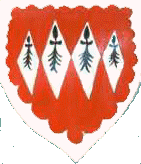Died: 28 Jan 1500/1
Buried: 30 Jan 1500/1, Grey Friars, London, Middlesex, England
Notes: Knight of the Garter.
Father: John DYNHAM (Sir Knight)
Mother: Joan ARCHES

John DYNHAM
(1st B. Dynham)
| Born: ABT 1436, Steeple, Ashton, Oxon, England Died: 28 Jan 1500/1 Buried: 30 Jan 1500/1, Grey Friars, London, Middlesex, England Notes: Knight of the Garter. Father: John DYNHAM (Sir Knight) Mother: Joan ARCHES |
|
Married 1: Elizabeth FITZWALTER (b. 28 Jul 1430, Henham - d. BEF 22 Aug 1485) (dau. Walter FitzWalter, 7° B. FitzWalter and Elizabeth Chidiock) (w. of Sir John Radcliffe) 15 Mar 1469, Woodhouse Walter, Essex, England
Children:
1. George DYNHAM (d. young)
Married 2: Elizabeth WILLOUGHBY lic. 26 Mar 1488
Born into a Devonshire gentry family related to the Courtenays, Earls of Devon, was the son of Sir John Dynham, De Jure 6th Lord Dynham, by his third wife, Phillippa, dau. of John, 6th Lord Lovell of Tichmarsh. Dynham married first Elizabeth Fitzwalter, sole heiress of Walter, Lord Fitwalter, and widow of Sir John Radcliffe. By this first marriage are descended the Radcliffes, Earls of Sussex. The second wife of John Dynham was Elizabeth Willoughby, possibly the same dau. of Robert, first Baron Willoughby of Broke, who was the first wife of William Fitzalan, 17° E. of Arundel.
Dynham rendered vital service to the Yorkist cause in Oct 1459, when, after guiding him from the Battle of Ludford Bridge, Dynham sheltered the future Edward IV while arranging for a vessel to carry him to safety at Calais. In the last months of 1459 Henry Beaufort, third Duke of Somerset wanted to liberate Calais from Richard Neville, Earl of Warwick, and he sailed from Sandwich with a large army. He was repelled by Yorkist forces, and captured Guisnes, one of the fortresses on the March of Calais, instead. The Lancastrians decided to build a new fleet for the purpose of helping the Guisnes garrison in the first few days of 1460. The fleet was supposed to be led by Richard Woodville, first Earl of Rivers. It was captured in Jan 1460, in a daring night raid by John Dynham, ally of Warwick, who crossed the Channel before Lord Rivers could mobilize his fleet. In the following Jun, Dynham again descended on Sandwich, defeating another Lancastrian force and seizing the town as a Yorkist bridgehead.
In 1461 Thomas Courtenay, sixth earl of Devon was beheaded by Edward IV as a result of his support for the House of Lancaster. The King granted the Barony of Okehampton to John Dynham, Sheriff of Devon. Named to the royal Council in 1462 and raised to the Peerage in 1467, Dynham became the chief Yorkist peer in the West Country by 1469. After the Yorkist restoration in 1471, Dynham became deputy at Calais. The last major military exploit of Edward IV's reign was the invasion of France in 1475. Edward IV sent out a fleet to ensure the security of the seas before the invasion fleet sailed, and added another ship to his personal fleet to help them. This fleet was led by John, Lord Dynham, who was given his commission in the spring of 1475. Dynham's fleet seemed to have done an excellent job, as the French had no idea when the ships were to arrive. Dynham, like most peers of the realm, had been involved in commissions of array and of oyer and terminer. He had also sat on two commissions of inquiry into acts of piracy.
In 1483, Dynham supported Richard, Duke of Gloucester's usurpation of the throne and was rewarded with the stewardship of the royal duchy of Cornwall. Dynham also received extensive land grants in the autumn of 1483 after remaining loyal to Richard III during Buckingham's Rebellion.
In Dec 1484, Dynham recaptured the Calais fortress of Hammes from its turncoat garrison, which had defected to Henry Tudor, Earl of Richmond. Perhaps because he allowed the Hammes garrison to march away, Dynham was replaced in the Calais command in 1485 by Richard's bastard son, John of Gloucester. Dynham remained in Calais as one of Gloucester's deputies. It is possible that Dynham may have connived at the escape of Henry's supporter, John De Vere, Earl of Oxford, from imprisonment at Calais in 1484. If true, Dynham mar have already been a secret adherent of the Tudor cause before Richard' s death.
Dynham was not present at the Battle of Bosworth Field in Aug 1485. He quickly won the trust of Henry VII, who retained Dynham on the council and named him Lord Treasurer in Feb 1486. Dynham became one of Henry VII's most active councilors, serving on many royal boards and commissions, including a 1488 commission charged with reforming the administration of Crown lands. Dynham also received numerous other offices and honors.
Dynham died in Jan 1500/1. His coheirs were his four sisters or their representatives: Joan Dynham (m. John Zouche, 7º B. Zouche of Harrynghworth); Catherine Dynham (m. Sir Thomas Arundell); Elizabeth Dynham (w. of Fulke Bourchier, 2° B. Fitzwarin and of Sir Thomas Brandon) and Margaret Dynham (m. Sir Nicholas Carew)
Sources:
Wagner, John A: Bosworth Field to Bloody Mary: An Encyclopedia of the early Tudors.
 to Bios Page
to Bios Page |
 to Home Page
to Home Page |